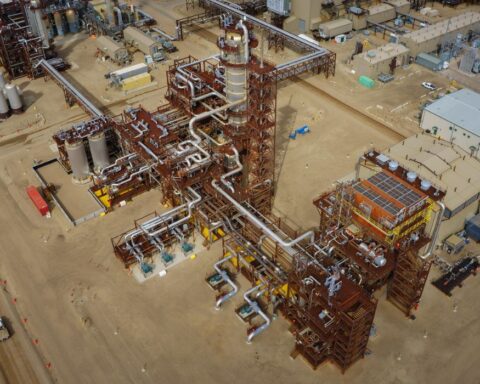As of November, homeowners who heat their abodes with oil have been exempt from the federal fuel charge, or carbon tax. This reversal of one of the crown jewels of the federal government’s climate policies added fuel to the heated public debate over the carbon tax.
This policy flip-flop, mixed with poor government communication and sustained attacks by politicians that prey on affordability concerns, isn’t advancing Canada’s economic or environmental objectives. Never mind the generous rebate cheques distributed by the federal government, leaving most families better off, or the drag on national prosperity from the wilder weather and extreme storms that heat-trapping pollution brings. This ongoing debate is a dangerous distraction from the hard task of building effective, efficient climate policy.
But the carbon tax is not the whole carbon-pricing story in the country. Behind the scenes, industrial carbon pricing through large-emitter trading systems (LETS), including output-based pricing or cap-and-trading systems, is propelling Canada’s clean energy transition. A new report by the Canadian Climate Institute shows that this industrial price on carbon will be roughly three times more effective at cutting emissions between now and 2030 than the carbon tax – contributing a whopping 53 to 90 megatonnes of reductions towards the 2030 target. And even in Alberta, industrial carbon pricing is alive and well – and bringing down emissions.
Since 2007, successive provincial governments in Alberta have updated their industrial carbon-pricing program targeting large emitters, including producers of oil and gas, chemicals and cement. And the basic design of Alberta’s system has been adopted across the country. Currently, 42% of national emissions are covered by federal, provincial and territorial LETS, with tradable emissions credits valued at $2.4 billion and rising with the national carbon price. By comparison, the federal fuel charge covers 34% of national emissions.
Despite the rhetoric against carbon pricing, governments of all political stripes have become comfortable making big polluters pay. But why? The answer is simple: LETS are good at reducing emissions, good for business and good for competitiveness. To remain effective, however, adjustments will need to be made.
Let’s look closer at what LETS have going for them.
LETS protect competitiveness by lowering costs
To keep balance-sheet costs manageable, the carbon price is applied to only a fraction of industrial emissions, with typically 75% to 90% of emissions unpriced. The incentive to reduce emissions, however, remains unchanged since every emission reduced is still valued at the full carbon price. With the carbon price rising to $170 by 2030, every tonne reduced is worth $170, while the compliance cost that firms face in that year ranges between $17 and $43 per tonne of emissions (assuming unpriced emissions are still 75% to 90%). This means that a chemical plant with 100,000 tonnes of emissions would see carbon costs somewhere between $1.7 and $4.25 million instead of $17 million if all emissions were priced.
As competitiveness risks change, regulators can change the quantity of unpriced emissions. They do this through revaluating the level of the performance standard, which sets the level of unpriced emissions, typically expressed as emissions per unit of production (i.e., allowable emissions per tonne of steel produced). Should competitiveness pressures worsen, the level of unpriced emissions can be increased, and vice versa. To assess competitiveness pressures, Alberta has a series of profit and sales tests that determine whether the financial impact of compliance on a facility is significant. These tests compare the costs of carbon pricing to firm profit or sales. If a threshold is exceeded, the quantity of unpriced emissions is increased, thereby lowering costs.
This scalability to changing competitiveness – or even technology conditions should abatement become easier due to innovation – makes LETS a flexible policy option.
LETS provide a revenue stream for low-carbon projects
Companies are able to sell credits when they reduce emissions and outperform their performance standard. And with carbon prices rising, emission credits will gain value. As this happens, firms can decide whether to sell credits at a profit or bank them to potentially apply them against rising future carbon-pricing costs. This profit motivation becomes particularly strong when assessing whether to invest in emissions-reduction technology, such as carbon capture, utilization and storage.
LETS protect against border carbon tariffs
LETS also help smooth protectionist waters as countries implement carbon border tariffs. With LETS in place, the risk that other countries will impose carbon tariffs on Canadian exports lowers. The protectionist winds are blowing hard out of Europe, where the European Union will apply a carbon price on imports from specific industries, including cement and steel. Various carbon protectionist tariffs are also being contemplated in the United States that would first assess the emission intensity of key products, including aluminum, cement, oil, fertilizer, iron and steel. The Unites States then would seek to apply a border carbon charge or tariff on carbon-intensive imports, increasing the market price in the United States for Canadian products.
Let’s get the details right
There are two big risks that need to be addressed to ensure that LETS can continue to contribute emission reductions in line with Canada’s climate targets. First, recent analysis by the Canadian Climate Institute indicates future LETS market prices don’t always hold at the national carbon price, notably in Alberta, due to an oversupply of credits. Credit oversupply can happen for a variety of reasons, including when firms are granted more credits than needed for compliance; technology investments, spurred by subsidies, generate large volumes of credits; and overlapping policies double count reductions. The institute’s analysis shows that addressing credit oversupply and some policy overlap, notably between LETS and the oil and gas emissions cap, can cut another 15 megatonnes of national emissions by 2030 from industrial processes. This 15 megatonnes equals more than a third of the reductions needed to close Canada’s 2030 emissions gap.
This policy fix is straightforward. Regulators need to routinely monitor and update greenhouse gas performance standards to make them stricter. The movement toward government insuring against uncertain future carbon prices, as in the case of carbon contracts for differences and credit offtake agreements, can also help maintain investment certainty.
Second, market transactions and trading prices are opaque and apart from Quebec’s cap-and-trade system, there is no foresight on the current or future value of emission credits in the LETS markets. This adds uncertainty for investors but also limits the ability for regulators to predict market imbalances and take corrective action. Canadian LETS markets are currently worth about $2.4 billion, but this value rises rapidly with the carbon price and stricter performance standards, growing to $6 to $7 billion by 2030. It’s astounding that market oversight and trading systems are not yet in place to track how these markets function and whether the market price holds.
It is no wonder that LETS are the policy tool of choice across Canada and across the political spectrum. These systems incentivize emission reductions, minimize competitiveness risks, and calm the threat of border tariffs on Canada’s exports.
LETS get the job done.
Dave Sawyer is principal economist with the Canadian Climate Institute and operates EnviroEconomics.







